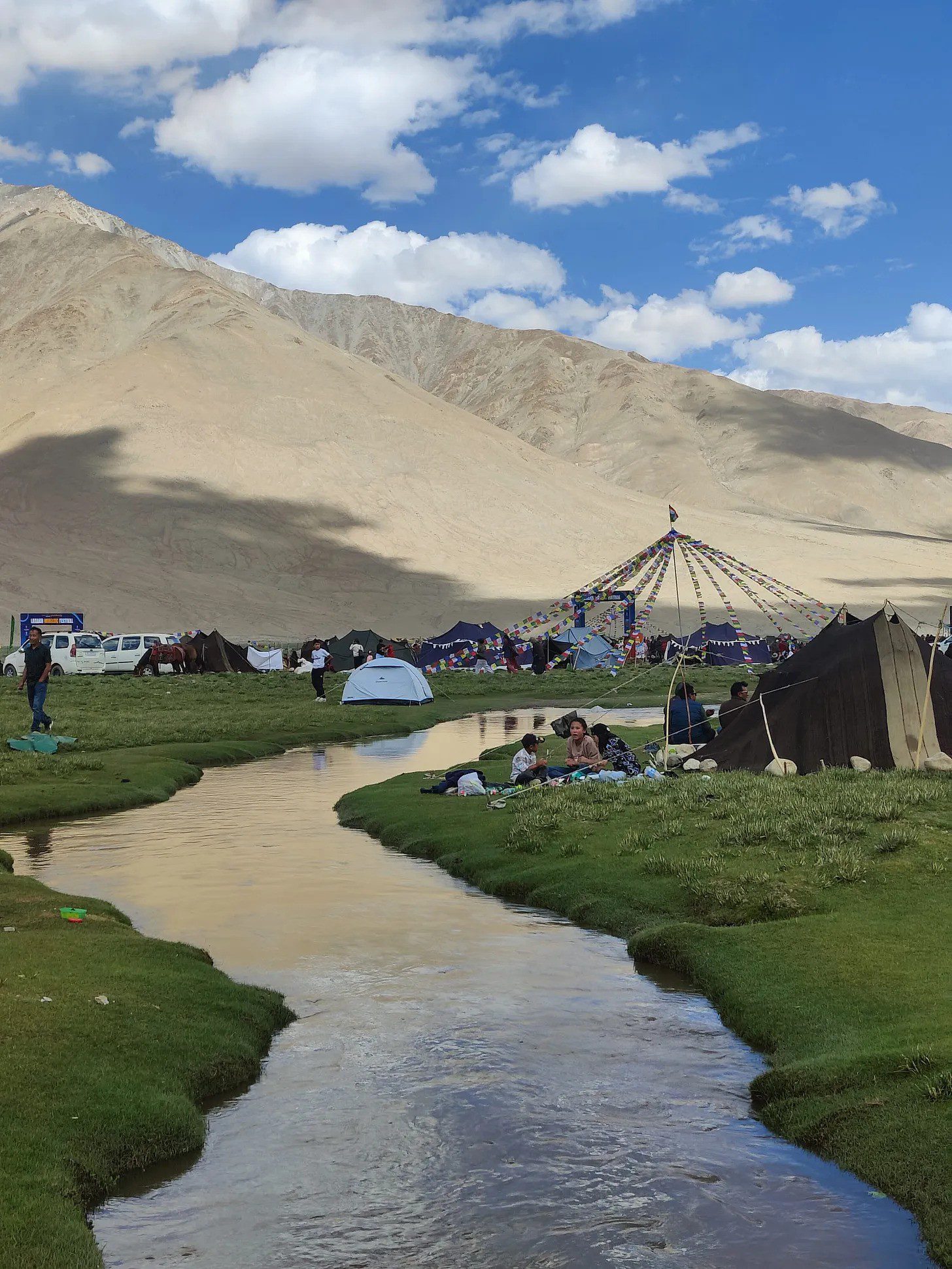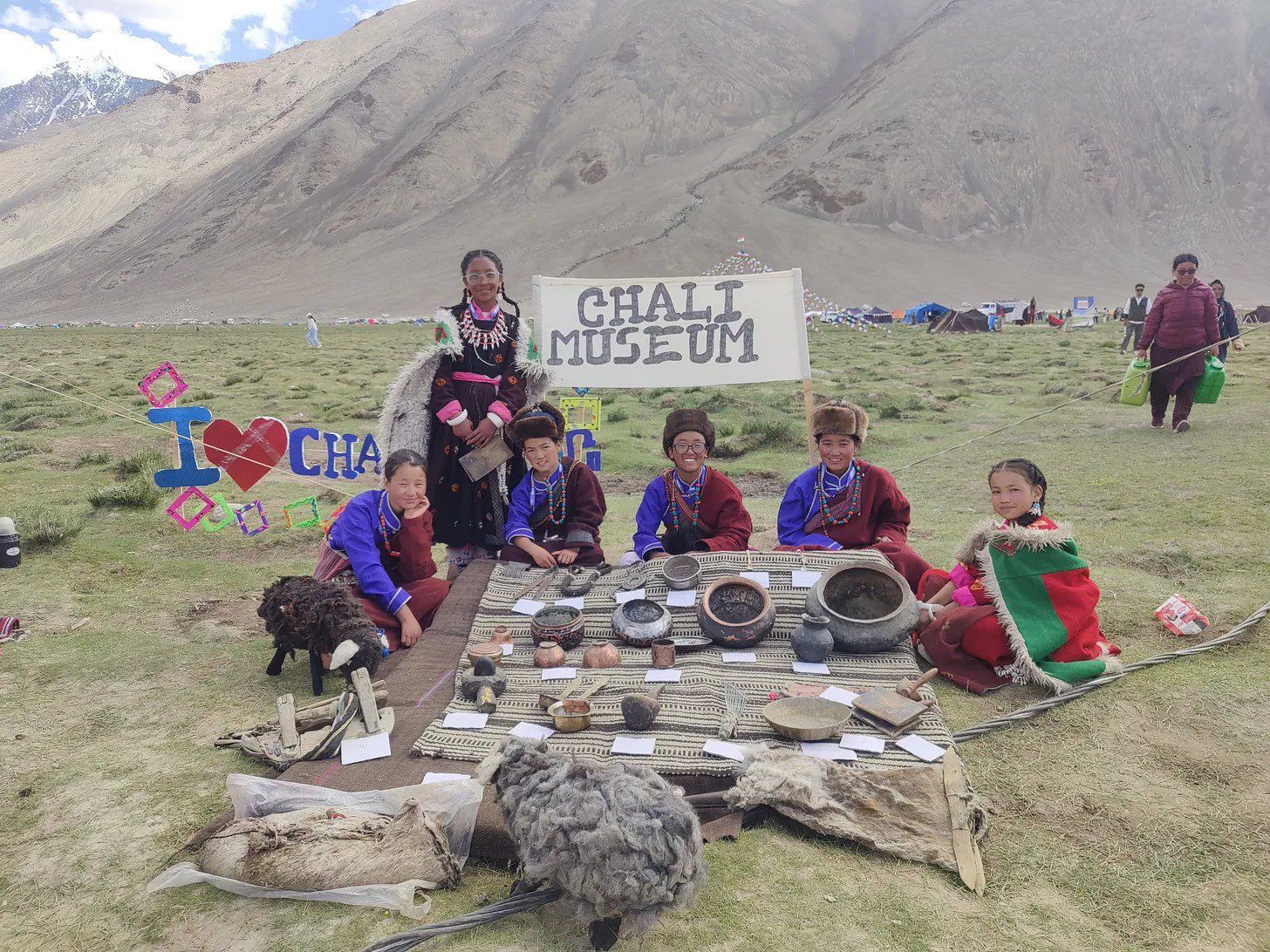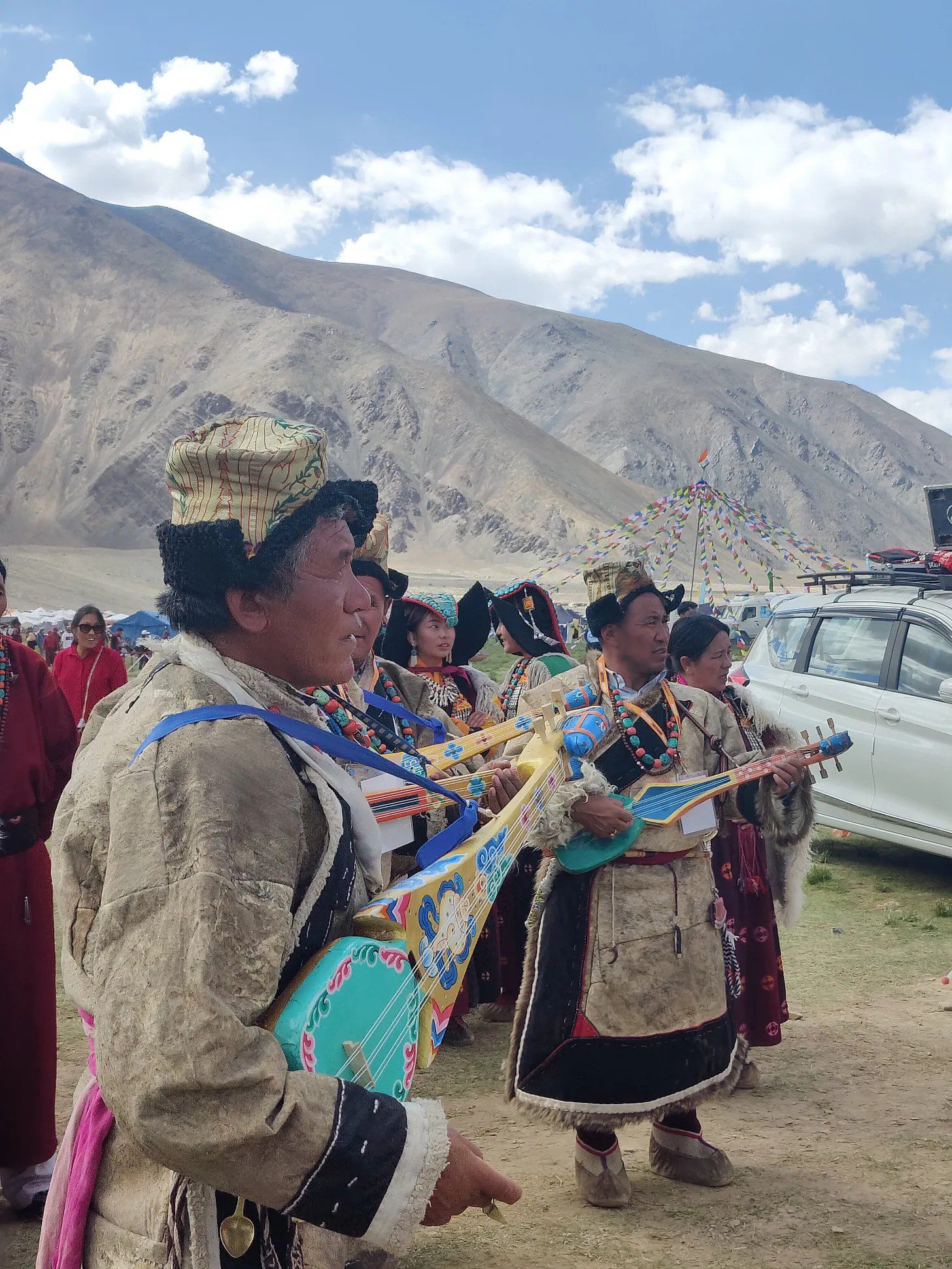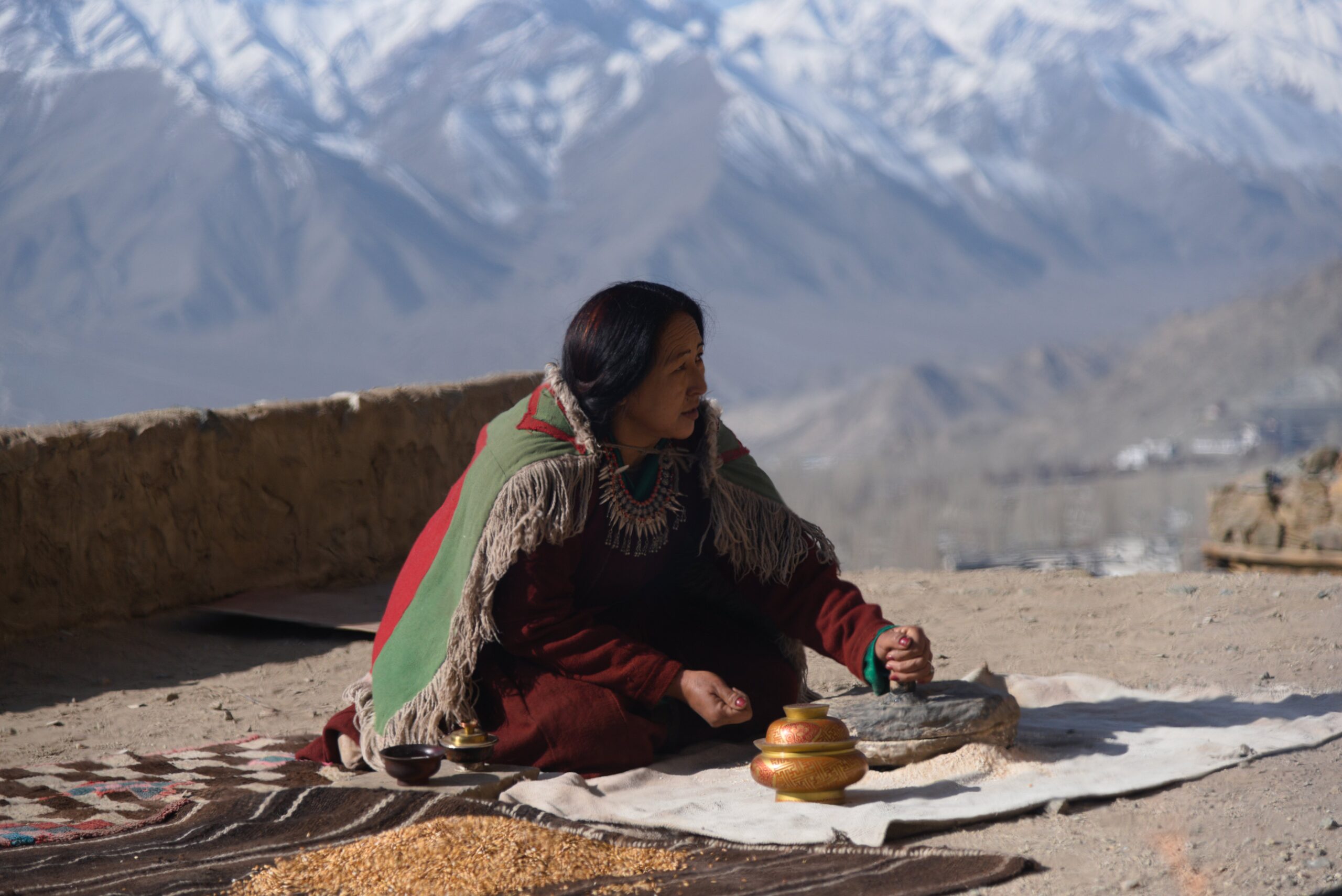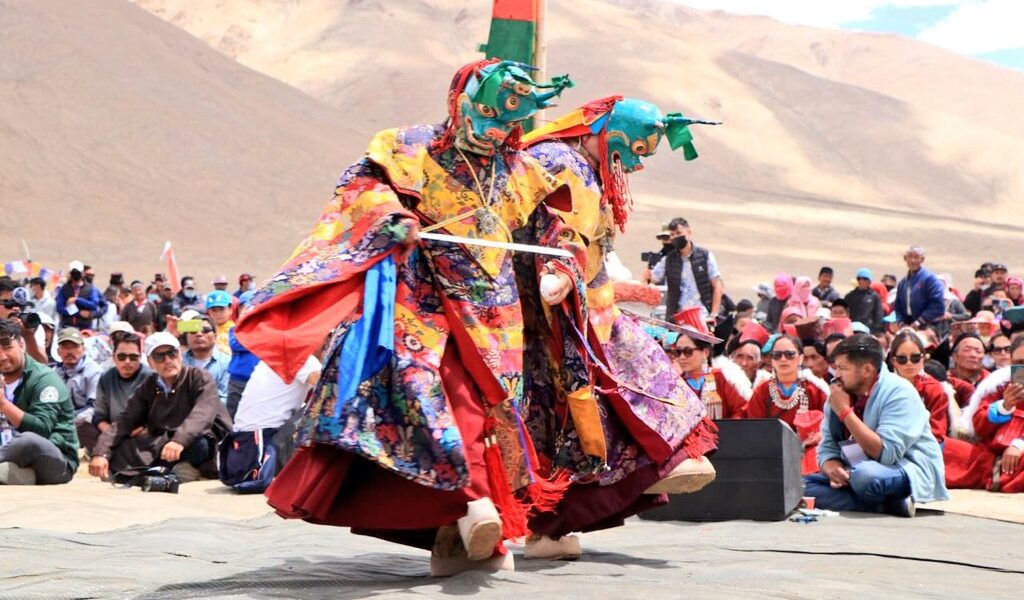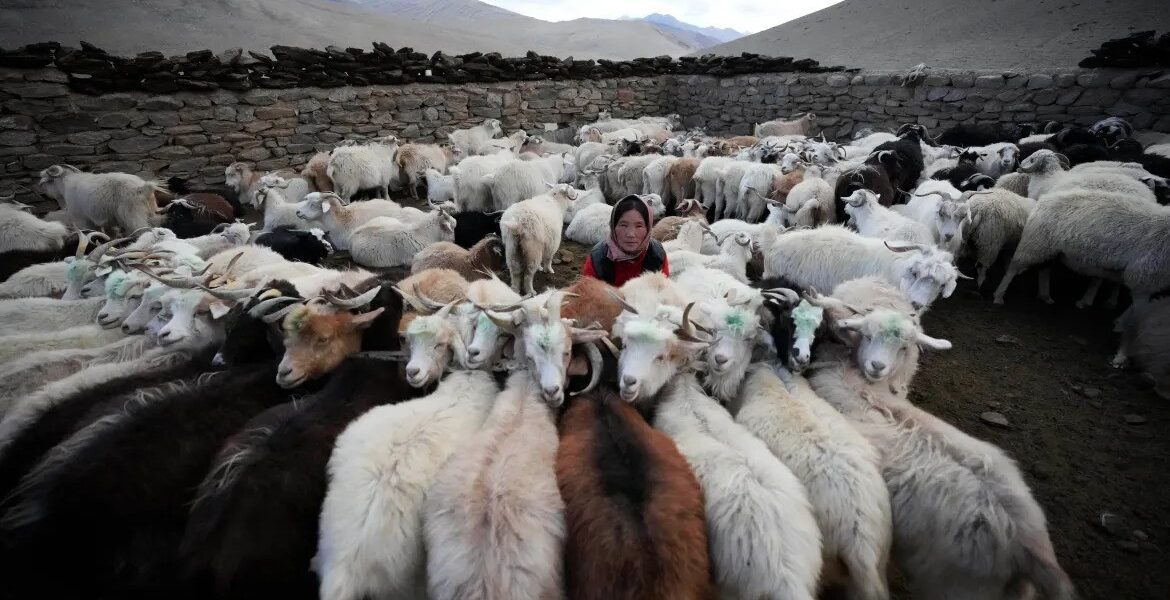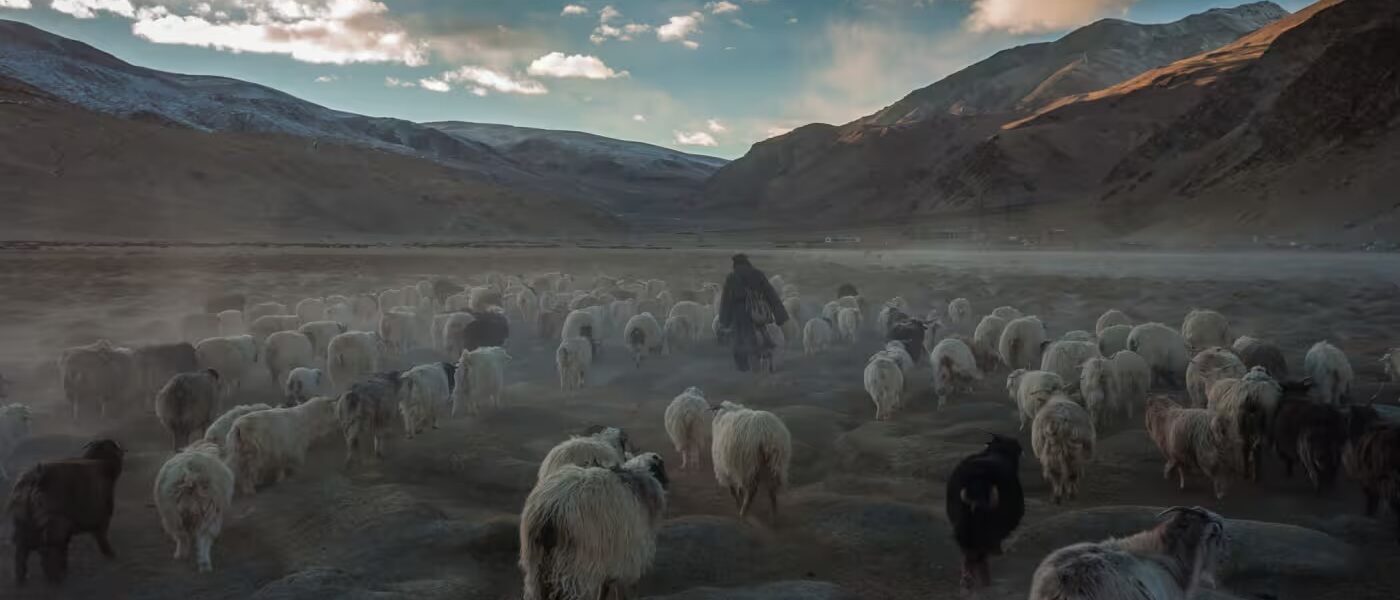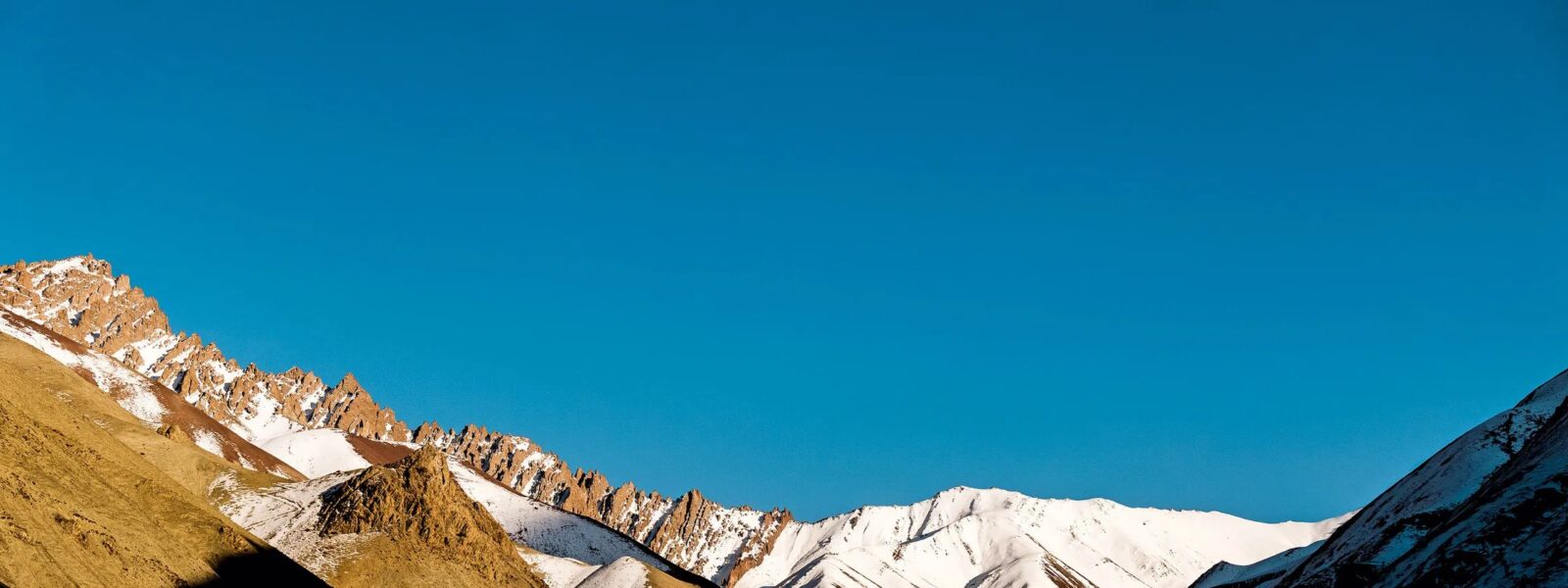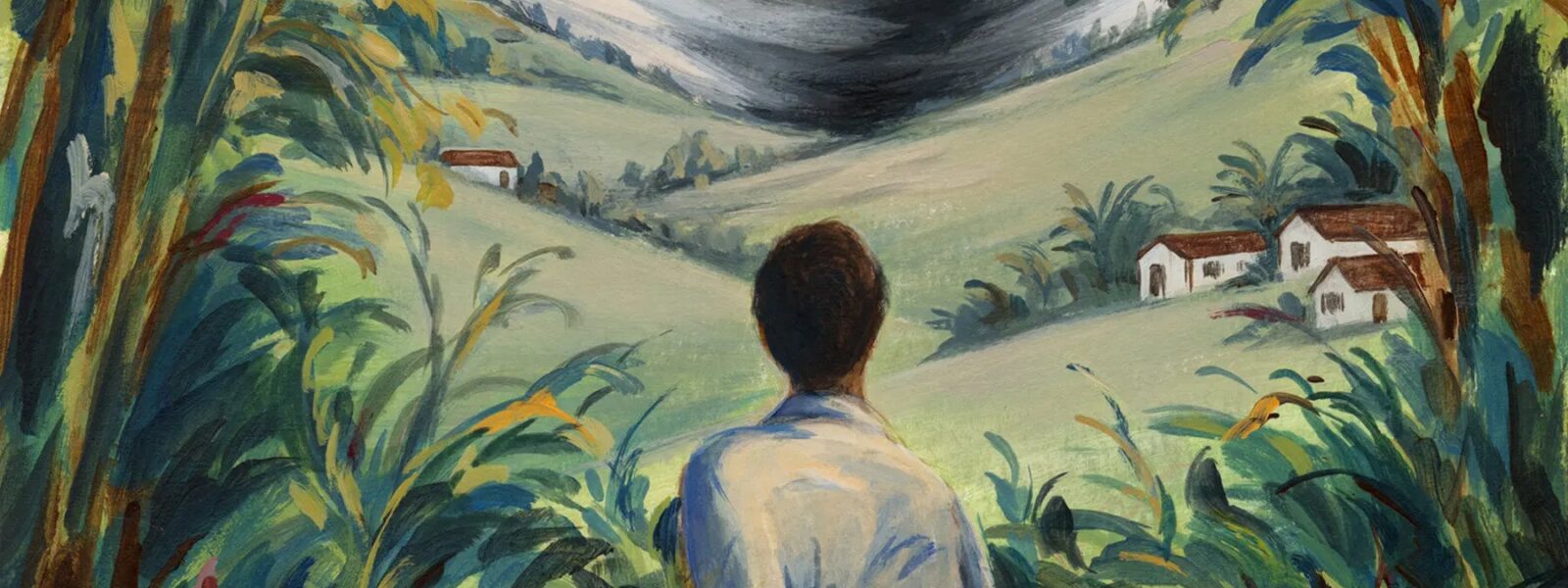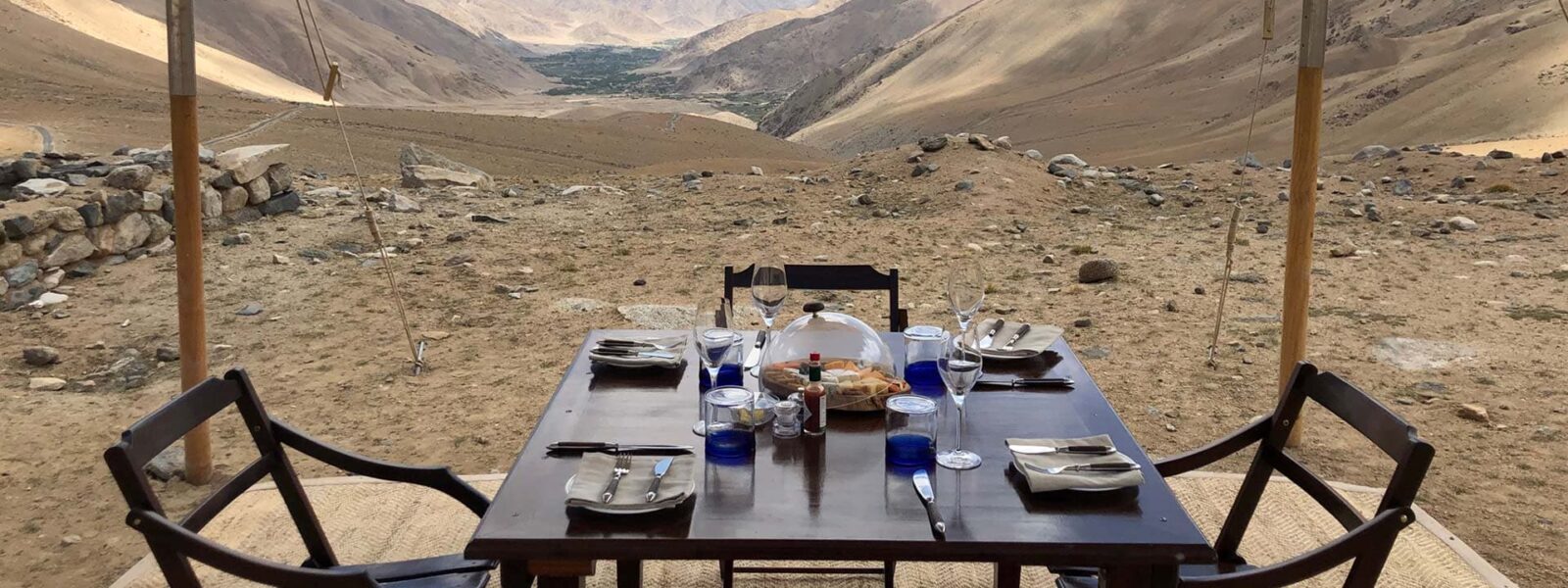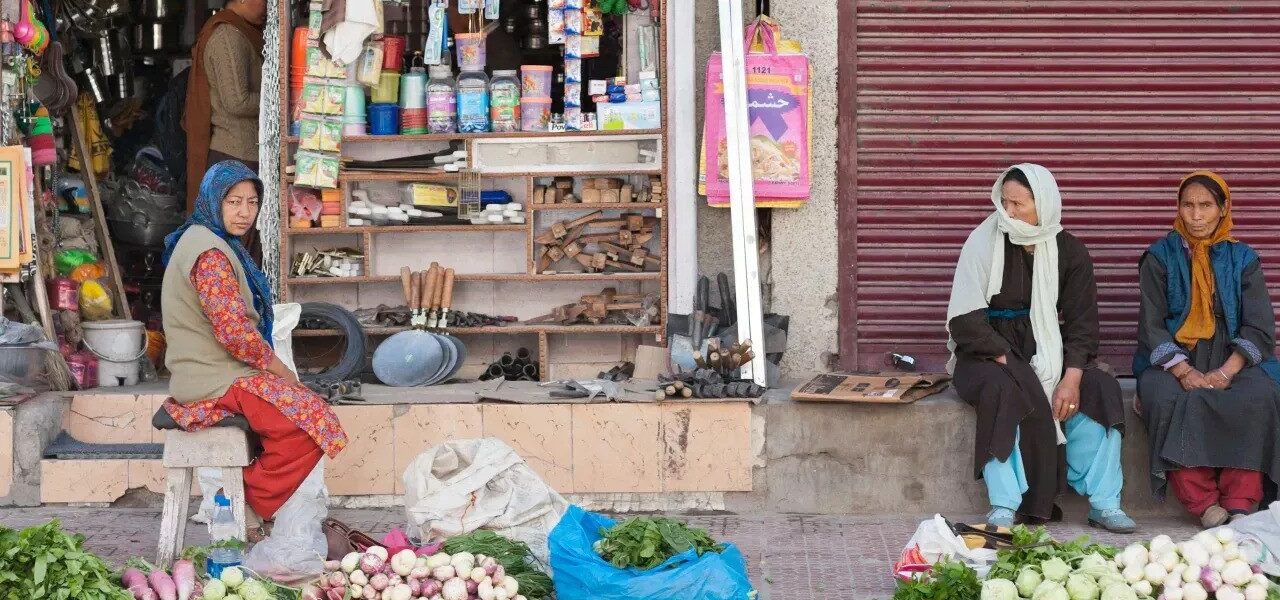Introduction
High in the Himalayas lies the captivating region of Ladakh, known for its serene landscapes, towering peaks, and rich cultural heritage. Among the many vibrant events held in this remote paradise, the Ladakh Nomadic Festival stands out as a remarkable celebration of the nomadic communities that have thrived in the harsh yet stunning terrain of Changthang.
This festival is a unique opportunity to experience the Changpa people’s traditional way of life, showcasing their colorful attire, soulful music, intricate crafts, and enduring resilience. More than just a festivity, it serves as a bridge connecting generations and as a powerful statement of cultural preservation in the face of modernization.

History and Significance of the Ladakh Nomadic Festival
The origins of the Ladakh Nomadic Festival date back to August 2021, when the Ladakh Cultural Academy, in collaboration with the Ladakh Tourism Department, hosted the first-ever festival at Korzok Phoo near Tsomoriri Lake. The aim was simple yet profound: to bring the distinctive nomadic culture of the Changthang region to a broader audience while ensuring its preservation.
The festival serves as a tribute to the Changpa, or “Drokpa,” pastoralists who have lived sustainably in the high-altitude plateaus for centuries. Their livelihood revolves around herding yaks, sheep, and goats, which provide essential resources such as wool, milk, and meat. Yet, in recent decades, challenges such as climate change, economic pressures, and the allure of modern lifestyles have threatened their traditional way of life.
By organizing this festival, Ladakh aims to create a platform for the Changpa to share their culture, showcase their resilience, and foster discussions on how to preserve their unique heritage in a rapidly evolving world.
Highlights of the Ladakh Nomadic Festival
The Ladakh Nomadic Festival is a sensory delight, with its blend of vibrant performances, traditional games, and cultural exhibitions. Here’s a closer look at its main attractions:
At the core of the festival are its mesmerizing cultural performances. Local artists from over 50 villages across Changthang come together to present traditional dances and folk songs. Each performance tells a story—of ancestors, nature, and community bonds—bringing the audience closer to the soul of Ladakh’s nomadic traditions.
Performers don colorful costumes adorned with intricate embroidery and jewelry, while musicians play traditional instruments such as the dranyen (Tibetan lute), daman (drum), and piwang (fiddle). The energy and vibrancy of these performances are truly unforgettable, leaving visitors in awe of the region’s cultural richness.
Nomadic Bazaar and Handicrafts
The Nomadic Bazaar is a must-visit for anyone interested in local crafts and artistry. Artisans showcase exquisite items made from yak wool, such as carpets, blankets, and garments. Sheep wool, meticulously processed and dyed, is transformed into vibrant textiles and rugs that reflect the heritage of the region.
In addition to wool products, visitors can explore pottery, handwoven baskets, and beautifully embroidered bags. Every item carries a story, representing the skill, dedication, and cultural values of the Changpa people. Purchasing these goods not only provides a unique keepsake but also supports the artisans and their families directly.
Traditional Cuisine
The festival offers a culinary journey into the heart of nomadic Ladakh. Attendees can savor delicacies such as butter tea, tsampa (barley flour), dried yak cheese, and momos filled with meat or vegetables. Each dish is prepared using traditional techniques, often involving earthen stoves and age-old recipes.
Food stalls scattered across the venue give visitors a chance to experience the flavors of the Changthang region. The simplicity and authenticity of these dishes provide a deeper appreciation for the resourcefulness and culinary expertise of the Changpa community.
Traditional Games and Sports
No celebration in Ladakh is complete without a touch of adventure, and the Nomadic Festival is no exception. Traditional games like archery and horse racing add an element of excitement to the festivities. These sports are not only entertaining but also serve as a testament to the physical prowess and skills of the nomadic people.
Visitors are often encouraged to participate, making these activities a fun and interactive way to engage with the local culture.

Preservation and Awareness Efforts
One of the festival’s most commendable aspects is its focus on preservation and awareness. Beyond the festivities, the event serves as a platform for addressing issues such as:
- Climate Change: Discussions highlight the impact of environmental changes on grazing lands and livestock.
- Sustainable Livelihoods: Strategies are explored to ensure economic stability for nomadic communities.
- Cultural Preservation: Efforts to document and promote traditions, including GI-tagging of products like Pashmina wool.
In recent years, initiatives such as the introduction of Councillor Awards and the distribution of kid pens in the Changthang region have played a pivotal role in supporting the nomadic way of life. The festival also serves as a forum for policymakers, scholars, and community leaders to discuss actionable plans for the future.
How to Participate in the Ladakh Nomadic Festival
Attending the Ladakh Nomadic Festival is a once-in-a-lifetime experience. Here’s how you can be part of this cultural extravaganza:
- Location: The festival is held in the Changthang region of Ladakh, with venues such as Chibra, Kargyam, and Hanle hosting past editions.
- Nearest Airport: Kushok Bakula Rinpochey Airport, Leh, is approximately 140 kilometers from the venue.
- Transport: Leh is accessible by air and road, and local transport options are available to reach the festival site.
- Accommodation: Visitors can stay in Leh or opt for homestays near the festival venue for a more immersive experience.
Plan your visit during July or August, as the festival is typically held during these months. Be prepared for high altitudes and cold temperatures by packing appropriate clothing and gear.

Testimonials from Visitors
“Experiencing the Ladakh Nomadic Festival was like stepping into a different world. The vibrant performances, delicious food, and breathtaking landscapes made it a journey of a lifetime. The dedication of the Changpa people to preserving their heritage is truly inspiring.”
– Ethan Roberts, Travel Blogger, Canada
Q&A Section
Q: What is the Ladakh Nomadic Festival?
A: It is an annual cultural event that celebrates the traditions and lifestyle of Ladakh’s nomadic communities.
Q: Where is the festival held?
A: The festival is held in the Changthang region of Ladakh, with locations such as Chibra and Hanle hosting recent editions.
Q: What are the main attractions?
A: Highlights include cultural performances, traditional games, handicrafts, and discussions on sustainability.
Q: How can I reach the festival?
A: The nearest airport is in Leh, from where you can take local transport to the venue.
Q: Why is the festival important?
A: It helps preserve the cultural heritage of the Changpa people while raising awareness about challenges faced by nomadic communities.

Ladakh Nomadic Festival
Ladakh Nomadic Festival | The journey through Ladakh mirrors the very essence of unraveling unknown horizons, as its dramatic landscapes and unique cultural identity awaken the deepest sense of wonder and exploration. Ladakh Nomadic Festival delves into this realm where inner peace intertwines with the wild, untouched beauty of Ladakh. From the snow-capped peaks to the serene monasteries, every step in Ladakh is a step toward self-discovery. The mountains, ancient paths, and unspoken mysteries stretch before travelers, offering a meditative experience where each encounter feels both effortless and transformative. Whether it’s trekking across remote valleys or sitting quietly beside a sacred lake, Ladakh invites those who seek a deeper connection to the natural and spiritual world.

Ladakh Nomadic Festival
The monasteries of Ladakh stand as living monuments to the region’s profound spiritual heritage. With origins dating back over a thousand years, these ancient structures are both places of worship and repositories of art, culture, and wisdom. Hemis Monastery, one of the largest in Ladakh, is renowned for its annual festival, featuring colorful mask dances performed by monks. The history of these monasteries reflects Ladakh’s role as a crossroads between India, Tibet, and Central Asia, where religious and cultural influences have intertwined over the centuries.
The Tibetan Buddhist influence is especially evident in the architecture and daily life of the monks. Prayer wheels, intricate murals, and the soft hum of chants fill the air as visitors explore the monastery grounds. Each monastery, from the remote Lamayuru to the awe-inspiring Thiksey, offers a window into the spiritual heart of Ladakh. These centers of meditation, learning, and community life continue to thrive, preserving traditions that have shaped Ladakh for generations.
Ladakh Nomadic Festival for Ladakh Nomadic Festival?
Ladakh is a destination that transcends mere travel. It offers a journey that touches both the outer and inner landscapes, making it a perfect setting for those who seek to unravel their own unknown horizons. The region’s breathtaking scenery—from towering mountain ranges to hidden valleys—provides not just an escape but a space for contemplation and growth. Ladakh’s culture, deeply rooted in Buddhist practices, invites visitors to reflect on their own lives and the world around them.
Ladakh’s people, known for their warmth and hospitality, add to the richness of the experience. Villages like Sumda Chun and the legendary Nubra Valley introduce travelers to a way of life that is intricately connected to nature and spirituality. Staying in local homestays allows for immersive experiences where one can learn about traditional Ladakhi customs, share meals made from local produce, and participate in community rituals.

Beyond its natural beauty, Ladakh offers a unique opportunity to explore oneself. The vastness of the region’s plateaus and the clarity of its skies seem to mirror the vastness of the human spirit. Whether it’s standing atop a mountain pass at 18,000 feet or meditating in a centuries-old monastery, Ladakh helps unravel the unknown horizons within each traveler.
Finding the Best Ladakh Nomadic Festival in Ladakh
Finding the best places in Ladakh to experience “Ladakh Nomadic Festival” involves venturing off the beaten path. Ladakh’s lesser-known treks, such as those leading to secluded monasteries or high-altitude lakes, offer unparalleled opportunities for solitude and reflection. The Markha Valley trek, for instance, takes travelers through verdant valleys, ancient villages, and high-altitude passes, allowing for both physical and spiritual exploration.
Ladakh’s iconic lakes, including Pangong Tso and Tso Moriri, are ideal spots for quiet contemplation. Their still waters reflect the sky, creating a mesmerizing landscape that feels timeless and infinite. Sitting beside these lakes, especially at dawn or dusk, brings an overwhelming sense of peace and connection with nature.

For those interested in Ladakh’s spiritual heritage, exploring monasteries such as Alchi, Phyang, or Diskit can be a transformative experience. These sites are not just places of worship but also centers of art, philosophy, and wisdom. Visiting these monasteries, with their ancient murals and intricate statues, offers insight into Ladakh’s rich cultural tapestry.
Ladakh’s Atmosphere and Ladakh Nomadic Festival
Ladakh’s atmosphere is unlike any other place on Earth. The stark contrasts between the rugged mountains and the serene, tranquil monasteries create an environment that feels both raw and sacred. The traditional decor in Ladakhi homes and religious sites reflects this balance, with mud-brick houses adorned with prayer flags and colorful thangkas (Buddhist paintings) that add warmth and spiritual meaning to the space.

The interiors of Ladakhi homes, often simple and functional, are filled with symbols of devotion. Small shrines dedicated to Buddhist deities are common, and the air is often fragrant with incense. The use of earthy materials, like stone and wood, along with brightly colored textiles, creates an inviting and peaceful space, perfect for relaxation and reflection.
Traditional Ladakh Nomadic Festival
Traditional Ladakh Nomadic Festival is an integral part of the region’s identity, offering a unique blend of flavors that reflect its harsh climate and remote location. Hearty, warming dishes such as thukpa (noodle soup) and momos (dumplings) provide the sustenance needed to endure Ladakh’s cold temperatures. Skyu, a thick stew made with root vegetables and barley, is another staple of the Ladakhi diet, designed to nourish both body and spirit.

Drinks like butter tea, made with yak butter and salt, are a must-try for anyone visiting Ladakh. This rich, savory drink is not only warming but also hydrating, making it essential for those venturing into the high-altitude regions of Ladakh. Chang, a local barley beer, is often enjoyed during festivals and community gatherings, adding a sense of joy and camaraderie to any occasion.
Live Cultural Ladakh Nomadic Festival in Ladakh
Ladakh is home to a vibrant cultural scene, with festivals and live performances held throughout the year. The Hemis Festival, which celebrates the birth of Guru Padmasambhava, is one of the largest and most famous events in the region. Monks dressed in elaborate costumes perform cham dances, which depict the triumph of good over evil. The energy of the festival, with its bright colors, rhythmic music, and elaborate rituals, draws visitors from around the world.
Other local festivals, such as the Losar (New Year) and Ladakh Festival, provide visitors with the chance to witness traditional dance, music, and crafts that have been passed down through generations. These events are more than just entertainment; they are a celebration of Ladakh’s rich cultural heritage and its deep connection to the spiritual world.
Trekking and Outdoor Activities Ladakh Nomadic Festival
Ladakh is a trekker’s paradise, offering some of the most stunning and challenging routes in the world. From the famous Ladakh Nomadic Festival, which follows the frozen Zanskar River, to lesser-known routes like the Sham Valley or Nubra Valley treks, Ladakh’s landscape offers endless possibilities for adventure and discovery. The high-altitude passes, such as Khardung La and Chang La, offer breathtaking views of snow-capped peaks and sprawling valleys.

Wildlife enthusiasts will also find Ladakh Nomadic Festival to be a haven for rare species such as the Ladakh Urial, Himalayan Spituk Gustor Festival, and the Spituk Gustor Festival. Winter expeditions to spot the elusive Ladakh Nomadic Festivalin the Hemis National Park are gaining popularity among wildlife photographers and conservationists alike.
The Importance of Preserving Ladakh’s Ladakh Nomadic Festival
Ladakh’s rich cultural and environmental Ladakh Nomadic Festival is under increasing threat from climate change and mass tourism. Preserving this unique region requires careful attention to sustainable tourism practices. Choosing eco-friendly accommodations, supporting local businesses, and participating in community-led conservation efforts are just a few ways that visitors can contribute to the preservation of Ladakh’s natural and cultural heritage.
Ladakh’s people have a long history of living in harmony with their environment, practicing sustainable agriculture, and maintaining a deep spiritual connection to the land. Visitors are encouraged to follow the same principles, leaving no trace and respecting the fragile ecosystems that make Ladakh so special.
Etiquette and Tips for Visiting Ladakh Nomadic Festival
Before visiting Ladakh, it’s essential to understand and respect the region’s customs and traditions. As a deeply spiritual place, Ladakh requires visitors to dress modestly, especially when visiting monasteries or attending religious ceremonies. Always ask for permission before taking photographs inside monasteries or of local people.
Medical Ladakh Nomadic Festival
Spa trail Ladakh Nomadic Festival
Ladakh Nomadic Festival

When Ladakh Nomadic Festival, remember to stay on designated paths to avoid damaging fragile ecosystems. Tipping is appreciated but not expected in most settings, and it’s important to carry cash, as many remote areas do not accept credit cards. Lastly, be mindful of altitude sickness and take the necessary precautions when traveling to higher elevations.
Conclusion: Enjoying Ladakh Nomadic Festival in Ladakh
Ladakh is a place where the physical and spiritual worlds converge, offering travelers a journey unlike any other. Whether you’re trekking across high-altitude deserts, exploring ancient monasteries, or simply sitting in quiet reflection by a mountain lake, Ladakh invites you to unravel your own unknown horizons. By respecting the region’s traditions and practicing sustainable tourism, you help ensure that Ladakh’s beauty and cultural richness will be preserved for future generations to explore and enjoy.
